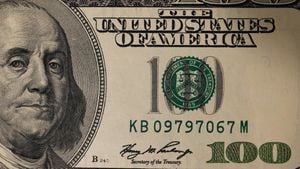With the political tides shifting once again, the world is watching closely how Donald Trump’s re-election could shake up not only the U.S. economy but also global markets. Experts are brewing up theories and speculations about what might come next as discussions around potential tariffs loom large on the horizon.
After Trump’s first term saw significant shifts, particularly with his controversial trade policies, the anticipation of his return to the White House brings both hopes and jitters among global investors, especially those based in Asia. Predictions from Korea's Institute for Industrial Economics and Trade (KIET) estimate the nation's economy will grow by 2.1% next year. But there's a catch; the report indicates this growth is marred by uncertainties stemming from Trump’s economic policies, particularly his approach to tariffs on trade.
During his initial presidency, Trump frequently threatened to impose tariffs, particularly on Chinese imports, as means to combat what he labeled as unfair trade practices. His proposed tax changes were also supposed to come out of the revenue generated from these tariffs, rattling foreign trade partners and raising eyebrows around the globe. Now, as he again teeters on the brink of power, many wonder if the same tariff rhetoric will return with even greater intensity.
According to Matt Hodge, a Financial Planning Partner at Buzzacott, the economic ripple effects of Trump's mandate extend far beyond American borders. He pointed out, “A unified Republican government will almost certainly extend the expiring and expired provisions from the Tax Cuts and Jobs Act, as well as pursue ever more tax cuts.” Hodge goes on to speculate about the costs associated with these tax cuts, which could be as high as $7.75 trillion. Yet, if past patterns hold, it seems likely these plans may encounter hurdles due to the effects on the national deficit.
"
Trump believes tariffs are effective to rectify perceived trade imbalances," Hodge noted, explaining how tariffs on imports from China may spike once more, potentially following the same pattern of earlier tariffs but potentially aiming higher - at least for negotiation purposes. If Trump's trade policies lean more toward economic isolationism, countries like South Korea, which heavily depend on export-driven growth, might find themselves caught between retaliatory trade skirmishes.
The U.S. remains the largest global economy, and any significant swing will have multiple reverberations. For example, when Trump raised tariffs on specific products from various countries, South Korean steelmakers urged the government to prepare for another round of tariffs through establishing consultative bodies to analyze the situation. This proactive measure speaks volumes about the uncertainty felt among companies as they prepare for Trump's return.
"Much of this conversation of tariffs stems from past experiences under Trump's imports policy, which has left businesses around the world on edge, especially those heavily invested or dependent on the American market," said Hodge. Investors are trying to decipher how these tariff changes could impact the valuation of the South Korean won. The shifting forex fluctuations will add yet another layer of complexity for the Bank of Korea, raising questions on how closely these economic policies will actually link to global supply chains.
The weak performance of South Korea's Kospi index adds to the mounting worries. Instead of prospering from interactions across the global market, foreign and domestic investors seem to be seeking opportunities elsewhere, hinting at discontent with current economic policies. While there’s potential for positive effects, like bolstered exports if tariffs would favor South Korean goods, the risk of higher U.S. tariffs could offset any short-term gains and inflate operational costs.
Adding more fuel to the fire, the IMF has downgraded South Korea's growth forecast from 2.2% to potentially lower margins, indicating sluggish domestic demand as potential tariffs threaten to escalate. With the looming prospect of heightened tariffs, both the Korean government and businesses are bracing for impact. Various industries want more government backing, especially after this stress. Farmers, steelmakers, and tech enterprises are making their concerns known, pushing for support.
The dynamics between U.S. trade policies and South Korea's economic resilience undoubtedly collide on international markets. For example, should Trump’s policies wind up strengthening the U.S. dollar, some favorable outcomes will emerge for certain UK investors, converting investment returns favorably against foreign currencies.
It’s no wonder then why financial planners and strategists are urging for comprehensive evaluations during this perilous time. The uncertainty surrounding trade can easily shift the narrative of economic growth or stagnation as Trump's second term possibilities play out. Though the immediate reaction from investors may be speculatively driven, it appears many are prepared for potentially rocky road up ahead.
The broader implication remains whether Trump can stabilize these adjustments on foreign policies whilst maintaining harmony within the domestic sphere. His first term brought unforeseen challenges and controversies, and whether he can navigate this graphic reality twofold—the U.S. and its trade parters—remains the million-dollar question.
To conclude, as the world waits and watches, investors must tread carefully, and companies, especially those with transnational ties, will need to strategize with foresight. Because one thing seems clear: with Trump at the helm, nothing is certain except change.



